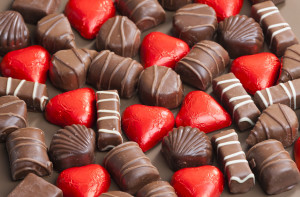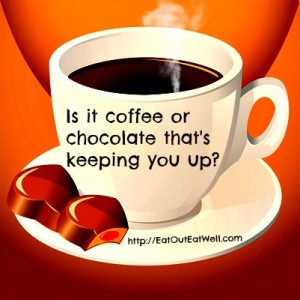
During the week before Valentine’s Day, about 1.1 billion boxed chocolates — that’s about 58 million pounds of chocolate candy — will be sold in the United States.
A pound of milk chocolate packs 2300 calories, 140 grams of fat, 270 grams of carbohydrates, and 31 grams of protein. Although a lot has been reported about the heart healthy benefits of chocolate, especially dark chocolate, it’s important to remember that it is still a high calorie, high fat treat. And, it has caffeine.
Isn’t Chocolate Good For Me?
Depending on the type and the amount, the answer is yes. Chocolate’s health benefits come from cocoa and dark chocolate has a higher concentration of it than milk chocolate. White chocolate, without any cocoa in it, is not really chocolate.
Chocolate, especially dark chocolate, contains flavonols which have antioxidant qualities and other positive influences on heart health. But typical Valentine’s chocolates are caloric and moderately high in fat, one-third of it the type of saturated fat that is not heart healthy. Extra ingredients like crème and caramel fillings can add lots of extra fat and calories.
And Then There’s The Caffeine
You’ve finished dinner – perhaps you’re stuffed to the gills – and some chocolate arrives along with the check. It could be those squares nicely wrapped in shiny foil or it could be some chunks of the really dark stuff artfully arranged on a plate.
Somehow there magically seems to be some room for the chocolate to fit in your already full belly. And, just maybe, this chocolate follows a chocolate dessert that tasted so fantastic that you wanted to lick the bowl. All of that was washed down by a wonderful cup of coffee.
Is it coffee or chocolate that’s keeping you awake?
Then you get home and sleep is just downright elusive. You wonder why you’re wide awake since you’ve been on the go all day.
Here’s a thought – it might be the caffeine found in the coffee, tea, and even some soda you’ve drunk and from the chocolate you nibbled (or devoured). There isn’t a huge amount of caffeine in chocolate, but perhaps enough – especially if you’re a chocoholic – to help tip the insomnia scales when it’s combined with a day’s worth of other caffeinated food and drinks.
Caffeine And Chocolate
Here are a few facts about chocolate and caffeine that most people don’t know:
Chocolate contains caffeine – not enough to give you a big time boost, but — depending on the type of chocolate, enough to register — especially if you’re working your way through some of those oversized bars or you’re a little kid stuffing in a bunch of fun-sized bars.
It would take about 14 regularly sized (1.5 oz) bars of milk chocolate, and fewer bars if they were dark chocolate (see stats below), to give you the same amount of caffeine that you’d get from an 8 ounce cup of coffee. Along with that little caffeine buzz you’d also be shoving in about 3,000 calories and more than 300 grams of sugar. If you’re looking for caffeine, coffee seems like a better bet at about two calories for an 8 ounce cup (black, no sugar).
Something To Think About
The next time you find yourself reaching for those foil wrapped chocolate squares after dinner you might consider the caffeine if you want a restful sleep.
It’s also worth it to remember that getting kids (and some adults) to sleep on Halloween, Easter, and other chocolate heavy holidays might have a whole lot to do with both the sugar and the amount of caffeine in the chocolate candy.
Caffeine In Chocolate
- Hershey’s Milk Chocolate Bar, 1bar/1.55 ounces: 9 mg caffeine
- Hershey’s Special Dark Chocolate Bar, 1 bar/1.45 ounces: 20 mg caffeine
- Hershey’s Kisses, 9 pieces: 9 mg caffeine
- Hershey’s Special Dark Kisses, 9 pieces: 20 mg caffeine
- Scharffen Berger Milk 41% Cacao, ½ bar: 17 mg caffeine
- Scharffen Berger Extra Dark 82% Cacao, ½ bar: 42 mg caffeine
- Dagoba Milk Chocolate 37% Cacao, ½ bar: 9 mg caffeine
- Dagoba Dark Chocolate 73% Cacao, ½ bar: 36 mg caffeine
Caffeine In Coffee
- Coffee, generic brewed, 8 ounces: 133 mg caffeine (range: 102-200; 16 ounces, 266 mg caffeine)
- Dunkin’ Donuts regular coffee, 16 ounces: 206 mg caffeine
- Starbucks Brewed Coffee (Grande), 16 ounces: 320 mg caffeine
- Coffee, generic instant, 8 ounces: 93 mg caffeine (range 27-173)
- Espresso, generic, 1 ounces: 40 mg caffeine (range 30-90)
- Starbucks Espresso, solo, 1 ounces: 75 mg caffeine
- Coffee, generic decaffeinated, 8 ounces: 5 mg caffeine (range 3-12)
If you are a traditionalist and just want a big old chocolate kiss on Valentine’s Day, here’s one already to go — just don’t eat it all at once or you’ll have a nice caffeine buzz!
Or maybe just a bag of pink chocolate kisses will do.
Or some gold milk chocolate kisses filled with caramel — yum!
My posts may contain affiliate links. If you buy something through one of the links you won’t pay a penny more but I’ll receive a small commission. I do not get compensated for reviews.



